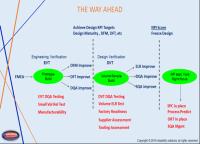 Add My Company
Add My Company
Sign In

Holistic Reliability – The Modern Day Solution
Holistic ‘ is a belief that the parts of something are intimately interconnected and explicable only by reference to the whole’
The meaning of the term ‘Holistic’ is very appropriate in today’s complex Electronic and Electro Mechanical products as we cannot assume a one off Accelerated Life Test, a small sample HALT test or a suite of specified environmental tests will highlight all the major latent defects which will lead to failure at some point in the products lifetime.
There are many different methods to be employed to fully understand and predict the Quality and Reliability of a New Product, these are often interconnected and all have a part to play in planning how we can best understand and predict the product performance.
Research and Development engineers have for many years applied DFMEA techniques to try to minimise possible issues, then perform some form of product stress test or ALT to attempt to predict the expected failure level. These techniques are sound, but often produce very little meaningful output unless the design is fundamentally poor.
In fast moving consumer product manufacture there are a wide range of sources that contribute to defects which are not directly related to the original design such as;
- Supply Chain Quality
- Assembly Process capability
- Design Quality issues
- Engineering Changes after Design exit
- Poor Test Coverage / Repeatability
- Etc
The key to achieving High Reliability is therefore a multi factor solution with focus on measurement wherever possible. Individual measurements alone may not provide the direct correlation to failure rate in the field, but the Holistic combination of the correct measurements certainly will. The key factors and measurements that contribute to minimising failures are highlighted below;
The Key Factors and measurements where appropriate include;
- Design Quality measured as % Design Maturity from Design Quality Assurance (DQA testing)
- Design for Manufacturing (DFM) scoring to measure ease of repetitive manufacture
- Design for Test Scoring (DFT) to measure Design focus on Testability and Test Coverage
- Factory Readiness Review scoring
- Supplier Quality Rating and scoring
- Supplier Quality monitoring with Early Life escape predictions from Yield measurement
- Early Life Reliability (ELR)Testing
- Accelerated Life Test
Only if all are driven to achieve highest possible level can we then expect world class reliability with a new product which can be maintained throughout its production life cycle, the simple flowchart is shown below.
It describes where each measurement should be made and how they will affect product performance through the design phase;
The final step is how then combining the measurements into a simple format that clearly highlights the performance outputs with an NPI matrix, Each element of the NPI matrix will have targets set and depending on the measurements made or defects found, the result of each measurement or test can be easily rated .
This is totally different from a quite normal approach where engineering groups argue over issues and commit to getting everything right before mass production.
Such an approach is always doomed to fail, hence the NPI model brings all the key measurements together for a professional and organised approach to monitoring a products performance from beginning to end in an HOLISTIC manner.
This model has worked very successfully with many of Reliability Solutions clients, if you would like to find out more contact us ;
Martin Shaw MD Reliability Solutions
www.reliabilitysolutions.co.uk
email : reliabilitysolutions@yahoo.co.uk
mob : ++44-7967-144097
For more information on Holistic Reliability – The Modern Day Solution talk to Reliability Solutions
Enquire Now
More related to Holistic Reliability – The Modern Day Solution
List your company on FindTheNeedle.

